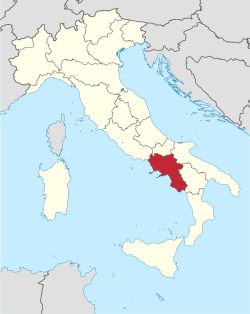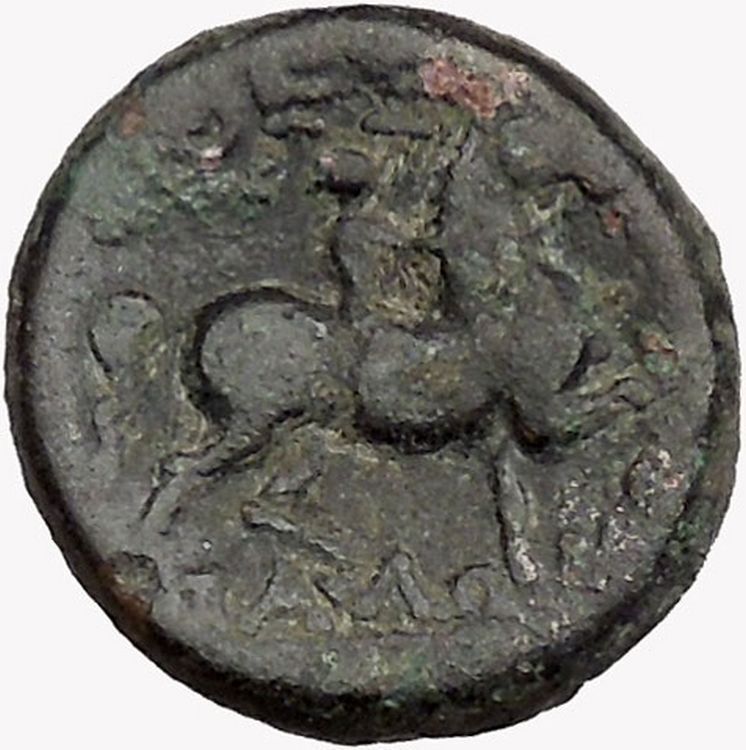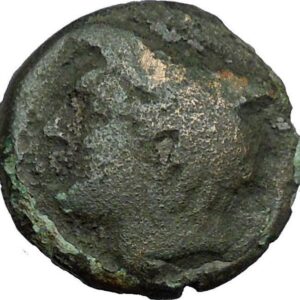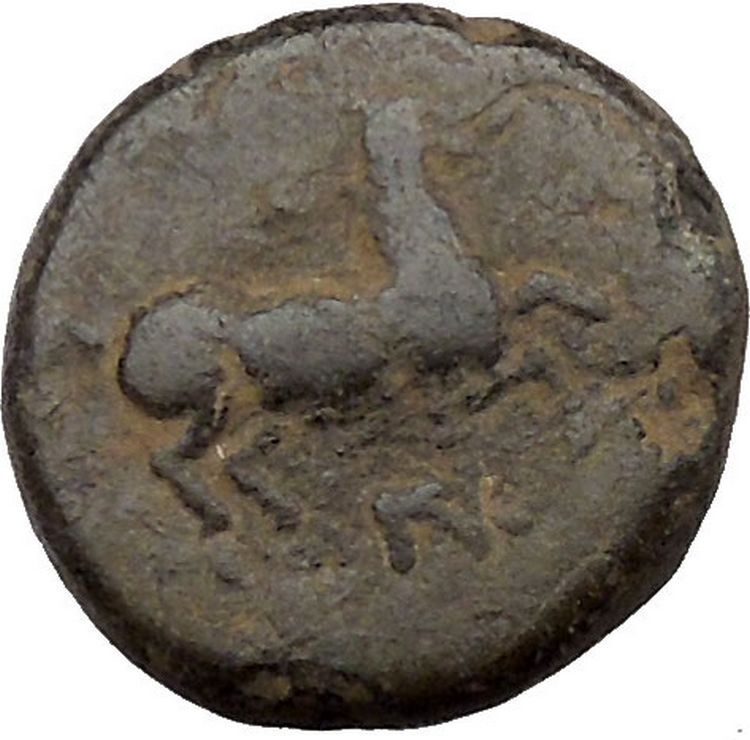|
Greek city of Neapolis in Campania
Bronze 20mm (4.00 grams) 250-225 B.C.
Reference: Cf. SNG ANS 530; cf. HN Italy 592
Laureate head of Apollo left within laureate wreath
Lyre leaning against omphalos; caduceus left, NEOΠΟΛIΤΩΝ in exergue.
Originally a Rhodian colony of very early foundation under the name of Parthenope, the city was recolonized by Kymaians circa 600 B.C. and its name finally changed to Neapolis circa 450 B.C. Allied with Rome from 326 B.C.
You are bidding on the exact item pictured, provided with a Certificate of Authenticity and Lifetime Guarantee of Authenticity.
 The caduceus (“herald’s wand, or staff”) is the staff carried by Hermes in Greek mythology and consequently by Hermes Trismegistus in Greco-Egyptian mythology. The same staff was also borne by heralds in general, for example by Iris, the messenger of Hera. It is a short staff entwined by two serpents, sometimes surmounted by wings. In Roman iconography, it was often depicted being carried in the left hand of Mercury, the messenger of the gods, guide of the dead and protector of merchants, shepherds, gamblers, liars, and thieves. The caduceus (“herald’s wand, or staff”) is the staff carried by Hermes in Greek mythology and consequently by Hermes Trismegistus in Greco-Egyptian mythology. The same staff was also borne by heralds in general, for example by Iris, the messenger of Hera. It is a short staff entwined by two serpents, sometimes surmounted by wings. In Roman iconography, it was often depicted being carried in the left hand of Mercury, the messenger of the gods, guide of the dead and protector of merchants, shepherds, gamblers, liars, and thieves.
Some accounts suggest that the oldest known imagery of the caduceus have their roots in a Mesopotamian origin with the Sumerian god Ningishzida whose symbol, a staff with two snakes intertwined around it, dates back to 4000 B.C. to 3000 B.C.
As a symbolic object, it represents Hermes (or the Roman Mercury), and by extension trades, occupations, or undertakings associated with the god. In later Antiquity, the caduceus provided the basis for the astrological symbol representing the planet Mercury. Thus, through its use in astrology and alchemy, it has come to denote the elemental metal of the same name. It is said the wand would wake the sleeping and send the awake to sleep. If applied to the dying, their death was gentle; if applied to the dead, they returned to life.
By extension of its association with Mercury and Hermes, the caduceus is also a recognized symbol of commerce and negotiation, two realms in which balanced exchange and reciprocity are recognized as ideals. This association is ancient, and consistent from the Classical period to modern times. The caduceus is also used as a symbol representing printing, again by extension of the attributes of Mercury (in this case associated with writing and eloquence).
The caduceus is often incorrectly used, particularly in North America, as a symbol of healthcare organizations and medical practice, due to confusion with the traditional medical symbol, the rod of Asclepius, which has only one snake and is never depicted with wings.
 In Greek and Roman mythology, Apollo, is one of the most important and diverse of the Olympian deities. The ideal of the kouros (a beardless youth), Apollo has been variously recognized as a god of light and the sun; truth and prophecy; archery; medicine and healing; music, poetry, and the arts; and more. Apollo is the son of Zeus and Leto, and has a twin sister, the chaste huntress Artemis. Apollo is known in Greek-influenced Etruscan mythology as Apulu. Apollo was worshiped in both ancient Greek and Roman religion, as well as in the modern Greco-Roman Neopaganism. In Greek and Roman mythology, Apollo, is one of the most important and diverse of the Olympian deities. The ideal of the kouros (a beardless youth), Apollo has been variously recognized as a god of light and the sun; truth and prophecy; archery; medicine and healing; music, poetry, and the arts; and more. Apollo is the son of Zeus and Leto, and has a twin sister, the chaste huntress Artemis. Apollo is known in Greek-influenced Etruscan mythology as Apulu. Apollo was worshiped in both ancient Greek and Roman religion, as well as in the modern Greco-Roman Neopaganism.
As the patron of Delphi (Pythian Apollo), Apollo was an oracular god – the prophetic deity of the Delphic Oracle. Medicine and healing were associated with Apollo, whether through the god himself or mediated through his son Asclepius, yet Apollo was also seen as a god who could bring ill-health and deadly plague as well as one who had the ability to cure. Amongst the god’s custodial charges, Apollo became associated with dominion over colonists, and as the patron defender of herds and flocks. As the leader of the Muses (Apollon Musagetes) and director of their choir, Apollo functioned as the patron god of music and poetry. Hermes created the lyre for him, and the instrument became a common attribute of Apollo. Hymns sung to Apollo were called paeans.
In Hellenistic times, especially during the third century BCE, as Apollo Helios he became identified among Greeks with Helios, god of the sun, and his sister Artemis similarly equated with Selene, goddess of the moon. In Latin texts, on the other hand, Joseph Fontenrose declared himself unable to find any conflation of Apollo with Sol among the Augustan poets of the first century, not even in the conjurations of Aeneas and Latinus in Aeneid XII (161-215). Apollo and Helios/Sol remained separate beings in literary and mythological texts until the third century CE.
 An omphalos is a religious stone artifact, or baetylus. In Greek, the word omphalos means “navel”. In Greek lore, Zeus sent two eagles across the world to meet at its center, the “navel” of the world. Omphalos stones marking the centre were erected in several places about the Mediterranean Sea; the most famous of those was at Delphi. Omphalos is also the name of the stone given to Cronus. In the ancient world of the Mediterranean, it was a powerful religious symbol. Omphalos Syndrome refers to the misguided belief that a place of geopolitical power and currency is the most important place in the world. An omphalos is a religious stone artifact, or baetylus. In Greek, the word omphalos means “navel”. In Greek lore, Zeus sent two eagles across the world to meet at its center, the “navel” of the world. Omphalos stones marking the centre were erected in several places about the Mediterranean Sea; the most famous of those was at Delphi. Omphalos is also the name of the stone given to Cronus. In the ancient world of the Mediterranean, it was a powerful religious symbol. Omphalos Syndrome refers to the misguided belief that a place of geopolitical power and currency is the most important place in the world.
The omphalos was not only an object of pagan religious symbolism and world centrality; it an also one of power. Its symbolic references included the uterus, the phallus, and a cup of red wine representing royal blood lines. It may also have connections to the Holy Grail and the Arthurian Sword in the Stone.
Most accounts locate the Delphi omphalos in the adyton (sacred part of the temple) near the Pythia (oracle). The stone sculpture itself (which may be a copy), has a carving of a knotted net covering its surface, and a hollow center, widening towards the base. The omphalos represents the stone which Rhea wrapped in swaddling clothes, pretending it was Zeus, in order to deceive Cronus. (Cronus was the father who swallowed his children so as to prevent them from usurping him as he had deposed his own father, Uranus).
Omphalos stones were believed to allow direct communication with the gods. Holland (1933) suggested that the stone was hollow to allow intoxicating vapours breathed by the Oracle to channel through it. Erwin Rohde wrote that the Python at Delphi was an earth spirit, who was conquered by Apollo and buried under the Omphalos. However, understanding of the use of the omphalos is uncertain due to destruction of the site by Theodosius I and Arcadius in the 4th century CE.
The omphalos at the Church of the Holy Sepulchre, Jerusalem, represents, in Christian mediaeval tradition, the navel of the world (the spiritual and cosmological centre of the world). Jewish tradition held that God revealed himself to His people through the Ark of the Covenant in the Temple in Jerusalem, which rested on the Foundation stone marking the centre of the world. This tradition may have stemmed from the similar one at Delphi.
The history of Naples is long and varied. The first Greek settlements were established in the Naples area in the 2nd millennium BC. During the end of the Greek Dark Ages a larger mainland colony – initially known as Parthenope – developed around the 9-8th century BC, and was refounded as Neapolis in the 6th century BC: it held an important role in Magna Graecia. The Greek culture of Naples was important to later Roman society. When the city became part of the Roman Republic in the central province of the Empire, it was a major cultural center. Virgil is an example of the political and cultural freedom of Naples. Naples is a microcosm of the European history because it saw several civilizations come and go, each leaving traces also in its art and architecture. Naples was the capital of duchies, kingdoms, and one Empire, and it was a primary cultural center (especially during the Renaissance humanism, 17th, 18th, 19th centuries). Naples was an advocate for Italian unification during the Neapolitan War. Today Naples is part of the Italian Republic, and is the third largest municipality (central area) by population, with the second largest metropolitan area (after Milan).
The Naples area has been inhabited since the Stone Age. Settlers from two cities in Euboea, Greece, jointly colonised the nearby Cumae, the earliest Greek city on mainland Italy. The earliest founding of Naples itself is claimed in legend to be the Greek colony Phaleron (Latin: Phalerum), after the hero Phaleros, one of the Argonauts.
However, the first Greek settlements were established on the site during the 2nd millennium BC. At the end of the Greek Dark Ages a larger mainland colony – initially known as Parthenope – developed around the 9-8th century BC. Parthenope was the name of the siren in Greek mythology, said to have washed ashore at Megaride, having throwing herself into the sea after she failed to bewitch Ulysses with her song. Around this time Greeks became locked in a power struggle with the Etruscans, who sought to dominate the area. Etruscans attacked Cumae (524 BC) and, although the attack failed, it signaled a growing Etruscan determination to dominate the area, the pressure of which pushed Parthenope to the commercial margins. There is evidence that the city had slid into decadence and, some argue, had virtually ceased to exist. However, literary evidence shows that the city was destroyed because the hegemony of Cumae was threatened.
Recent archaeological discoveries show that, in the 6th century (not in the 470 BC, after the battle of Cumae), the city was reoccupied and the new urban zone of Neapolis (Νεάπολις) was founded inland, eventually becoming one of the foremost cities of Magna Graecia. The primitive center of Parthenope came to be called simply Palaipolis (Latin: Palaepolis), the “old city”. The two separate centers were more diversified during the Samnite Wars. Neapolis had a powerful line of walls, in front of which the Carthaginian invader Hannibal had to retreat when the city was allied with the Romans. Other features were an odeon and a theatre, and the temple of the city’s patron gods, the Dioscuri, or divine twins (Castor and Pollux). Although conquered by the Samnites during the fifth century BC, and then the Romans, Naples long retained its Greek culture; it is significant that modern Neapolitans still refer to themselves often as Partenopei, “Parthenopeans”.
In the Roman era the city was a flourishing centre of Hellenistic culture that attracted Romans who wished to perfect their knowledge of Greek culture. The pleasant climate made it a renowned resort, as recounted by Virgil and manifested in the numerous luxurious villas that dotted the coast from the Gulf of Pozzuoli to the Sorrentine peninsula. The famous district of Posillipo takes its name from the ruins of Villa Pausílypon, meaning, in Greek, “a pause, or respite, from worry”. Romans connected the city to the rest of Italy with their famous roads, excavated galleries to link Naples to Pozzuoli, enlarged the port, and added public baths and aqueducts to improve the quality of life in Naples. The city was also celebrated for its many feasts and spectacles.
According to legend, the saints Peter and Paul came to the city to preach. Christians had a prominent role in the late years of the Roman Empire, and there are several notable catacombs, especially in the northern part of the city. The first palæo-Christian basilicas were built next to the entrances to the catacombs. The greatly popular patron of the city, San Gennaro (St. Januarius), was decapitated in nearby Pozzuoli in AD 305, and, since the 5th century, he has been commemorated by the basilica of San Gennaro extra Moenia. The Cathedral of Naples is also dedicated to St. Gennaro.
It was in Naples, in Lucullus’ Villa in what is now the Castel dell’Ovo, that Romulus Augustulus, the last nominal western emperor was imprisoned after being deposed in 476. Naples suffered much during the Gothic Wars between the Ostrogoths and the Byzantines during the 6th century. In 536, it decided to resist Belisarius’s invasion.  However, his troops captured the city by entering through its aqueduct. With the changing tide of the war in the 540s, it was starved into surrender by Totila, who treated it leniently. During Narses’s expedition during the 550s, it was captured by the Empire once again. When the Lombards invaded and conquered much of Italy in the following years, Naples remained loyal to the Byzantine Empire. However, his troops captured the city by entering through its aqueduct. With the changing tide of the war in the 540s, it was starved into surrender by Totila, who treated it leniently. During Narses’s expedition during the 550s, it was captured by the Empire once again. When the Lombards invaded and conquered much of Italy in the following years, Naples remained loyal to the Byzantine Empire.
Campania was colonised by Ancient Greeks and was part of Magna Græcia. During the Roman era, the area maintained a Greco-Roman culture. The capital city of Campania is Naples. Campania is rich in culture, especially in regard to gastronomy, music, architecture, archeological and ancient sites such as Pompeii, Herculaneum, Paestum and Velia. The name of Campania itself is derived from Latin, as the Romans knew the region as Campania felix, which translates into English as “fertile countryside”. The rich natural sights of Campania make it highly important in the tourism industry, especially along the Amalfi Coast, Mount Vesuvius and the island of Capri.
|





 The caduceus (“herald’s wand, or staff”) is the staff carried by Hermes in Greek mythology and consequently by Hermes Trismegistus in Greco-Egyptian mythology. The same staff was also borne by heralds in general, for example by Iris, the messenger of Hera. It is a short staff entwined by two serpents, sometimes surmounted by wings. In Roman iconography, it was often depicted being carried in the left hand of Mercury, the messenger of the gods, guide of the dead and protector of merchants, shepherds, gamblers, liars, and thieves.
The caduceus (“herald’s wand, or staff”) is the staff carried by Hermes in Greek mythology and consequently by Hermes Trismegistus in Greco-Egyptian mythology. The same staff was also borne by heralds in general, for example by Iris, the messenger of Hera. It is a short staff entwined by two serpents, sometimes surmounted by wings. In Roman iconography, it was often depicted being carried in the left hand of Mercury, the messenger of the gods, guide of the dead and protector of merchants, shepherds, gamblers, liars, and thieves. In Greek and Roman mythology, Apollo, is one of the most important and diverse of the Olympian deities. The ideal of the kouros (a beardless youth), Apollo has been variously recognized as a god of light and the sun; truth and prophecy; archery; medicine and healing; music, poetry, and the arts; and more. Apollo is the son of Zeus and Leto, and has a twin sister, the chaste huntress Artemis. Apollo is known in Greek-influenced Etruscan mythology as Apulu. Apollo was worshiped in both ancient Greek and Roman religion, as well as in the modern Greco-Roman Neopaganism.
In Greek and Roman mythology, Apollo, is one of the most important and diverse of the Olympian deities. The ideal of the kouros (a beardless youth), Apollo has been variously recognized as a god of light and the sun; truth and prophecy; archery; medicine and healing; music, poetry, and the arts; and more. Apollo is the son of Zeus and Leto, and has a twin sister, the chaste huntress Artemis. Apollo is known in Greek-influenced Etruscan mythology as Apulu. Apollo was worshiped in both ancient Greek and Roman religion, as well as in the modern Greco-Roman Neopaganism. An omphalos is a religious stone artifact, or baetylus. In Greek, the word omphalos means “navel”. In Greek lore, Zeus sent two eagles across the world to meet at its center, the “navel” of the world. Omphalos stones marking the centre were erected in several places about the Mediterranean Sea; the most famous of those was at Delphi. Omphalos is also the name of the stone given to Cronus. In the ancient world of the Mediterranean, it was a powerful religious symbol. Omphalos Syndrome refers to the misguided belief that a place of geopolitical power and currency is the most important place in the world.
An omphalos is a religious stone artifact, or baetylus. In Greek, the word omphalos means “navel”. In Greek lore, Zeus sent two eagles across the world to meet at its center, the “navel” of the world. Omphalos stones marking the centre were erected in several places about the Mediterranean Sea; the most famous of those was at Delphi. Omphalos is also the name of the stone given to Cronus. In the ancient world of the Mediterranean, it was a powerful religious symbol. Omphalos Syndrome refers to the misguided belief that a place of geopolitical power and currency is the most important place in the world. However, his troops captured the city by entering through its aqueduct. With the changing tide of the war in the 540s, it was starved into surrender by Totila, who treated it leniently. During Narses’s expedition during the 550s, it was captured by the Empire once again. When the Lombards invaded and conquered much of Italy in the following years, Naples remained loyal to the Byzantine Empire.
However, his troops captured the city by entering through its aqueduct. With the changing tide of the war in the 540s, it was starved into surrender by Totila, who treated it leniently. During Narses’s expedition during the 550s, it was captured by the Empire once again. When the Lombards invaded and conquered much of Italy in the following years, Naples remained loyal to the Byzantine Empire.




